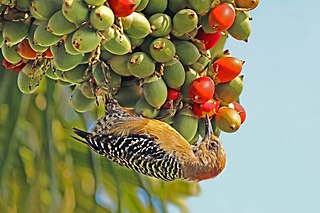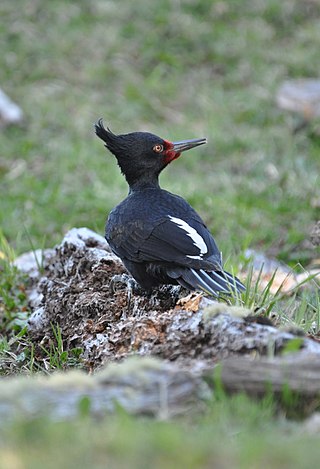
Nine families of largely arboreal birds make up the order Piciformes, the best-known of them being the Picidae, which includes the woodpeckers and close relatives. The Piciformes contain about 71 living genera with a little over 450 species, of which the Picidae make up about half.

Fortaleza Esporte Clube, usually known as Fortaleza, is primarily a football club, but is active in other sports such as futsal, handball and basketball. Fortaleza Esporte Clube is based in Fortaleza, capital of the State of Ceará, Brazil. The club was founded on October 18, 1918.

Bigoli[ˈbiːɡoli] is an extruded pasta in the form of a long and thick strand. Initially bigoli were made with buckwheat flour, but are now more commonly made with whole wheat flour, and sometimes include duck eggs. The preparation is then extruded through a bigolaro, from which the pasta gets its name.

Pici is one of the two suborders of the order Piciformes and includes two infraorders Ramphastides and Picides. Members of this suborder are often called "true piciforms", as the jacamars of Galbulidae and puffbirds of Bucconidae were thought to be not closely related to toucans and woodpeckers, but instead to the order Coraciiformes. However, analysis of nuclear DNA in a 2003 study placed them as a sister group to the rest of the Piciformes, also showing that the groups had developed zygodactyl feet before separating. Per Ericson and colleagues, in analysing genomic DNA, confirmed that puffbirds and jacamars were sister groups and their place in Piciformes.

Phytoecia is a genus of longhorn beetles of the subfamily Lamiinae,
Phytoecia gianassoi is a species of beetle in the family Cerambycidae. It was described by Sama in 2007 and later reclassified to the subgenus Coptosia within the genus Phytoecia.
Glenea pici is a species of beetle in the family Cerambycidae. It was described by Per Olof Christopher Aurivillius in 1925. It is known from Vietnam, India and Laos.
Phytoecia paulusi is a species of beetle in the family Cerambycidae. It was described by Holzschuh in 1971.

Phytoecia puncticollis is a species of beetle in the family Cerambycidae. It was described by Faldermann in 1837. It is known from Russia, Azerbaijan, Georgia, Iraq, Armenia, Turkey, Iran, and Turkmenistan. It feeds on Eryngium billardierei.
Phytoecia erivanica is a species of beetle in the family Cerambycidae. It was described by Reitter in 1899, originally as a varietas of Phytoecia pici. It is known from Iran, Armenia, and possibly Turkey.
Phytoecia gaubilii is a species of beetle in the family Cerambycidae. It was described by Mulsant in 1851. It is known from Tunisia and Algeria.

Phytoecia comes is a species of beetle in the family Cerambycidae. It was described by Henry Walter Bates in 1884. It is known from Taiwan, Myanmar, North Korea, South Korea, China, Vietnam, and Japan.
Phytoecia humeralis is a species of beetle in the family Cerambycidae. It was described by Waltl in 1838, originally under the genus Saperda. It is known from Palestine, Greece, Georgia, Iran, Azerbaijan, Syria, Cyprus, and Turkey. It feeds on Silybum marianum.
Phytoecia millefolii is a species of beetle in the family Cerambycidae. It was described by Adams in 1817, originally under the genus Saperda. It has a wide distribution between Europe and the Middle East.
Phytoecia praetextata is a species of beetle in the family Cerambycidae. It was described by Steven in 1817, originally under the genus Saperda. It is known from Turkey, Bulgaria, Syria, Armenia, Romania, and Ukraine.
Phytoecia affinis is a species of beetle in the family Cerambycidae. It was described by Harrer in 1784, originally under the genus Leptura. It has a wide distribution in Europe.

Phytoecia caerulescens is a species of beetle in the family Cerambycidae. It was described by Scopoli in 1763, originally under the genus Leptura. It has a wide distribution in Europe, and has been introduced into Australia. It feeds on Echium vulgare, Lappula squarrosa, Anchusa officinalis, Lithospermum officinale, and Cynoglossum officinale.

Phytoecia caerulea is a species of beetle in the family Cerambycidae. It was described by Scopoli in 1772, originally under the genus Leptura. It has a wide distribution in Europe.
Phytoecia hirsutula is a species of beetle in the family Cerambycidae. It was described by Frölich in 1793, originally under the genus Saperda. It has a wide distribution between Europe and the Middle East.

The history of photography in Albania begins with the Marubi Dynasty and its founder Pietro Marubi (1834–1903), who settled in the northwestern city of Shkodër from Piacenza, Italy during the second half of the nineteenth century and opened the first photography studio there in 1858. Having no children of his own, Marubi's first assistants and faithful successors were Mati and Kel Kodheli, the sons of his gardener Rrok Kodheli. Pietro sent Mati, the older of the two brothers, to study photography at the Sebastianutti & Benque studio in Trieste. When Mati died prematurely at age nineteen, in 1881, Pietro adopted Kel, whom he also sent to Italy to study and who would later assume the surname Marubi. Upon Pietro's death in 1903, Kel inherited his adopted father's studio and continued its work. He, in turn, was followed into business by his own son, Geg Marubi, who studied photography and cinematography in France at the Lumière brothers’ studio.









